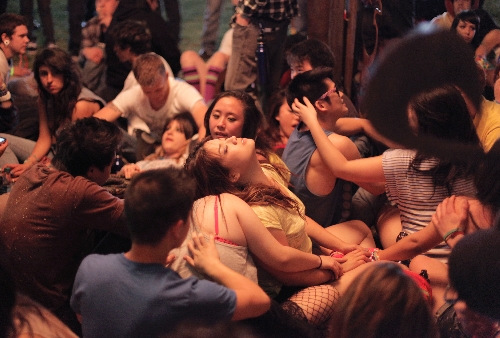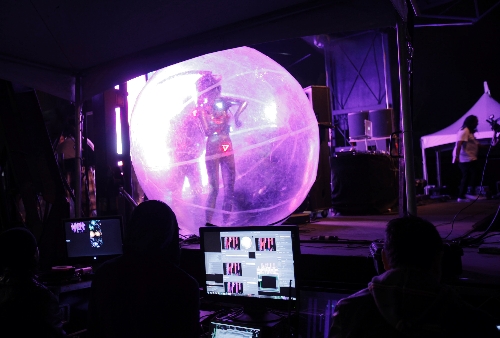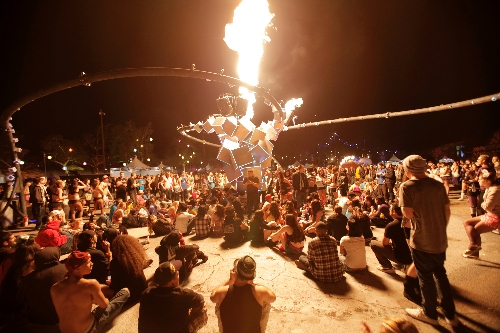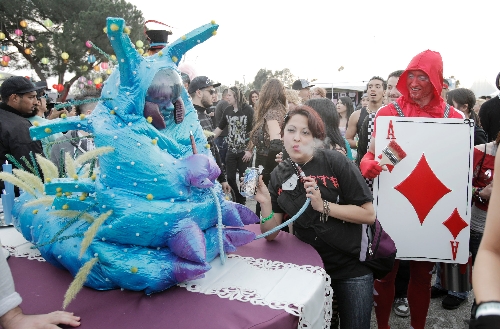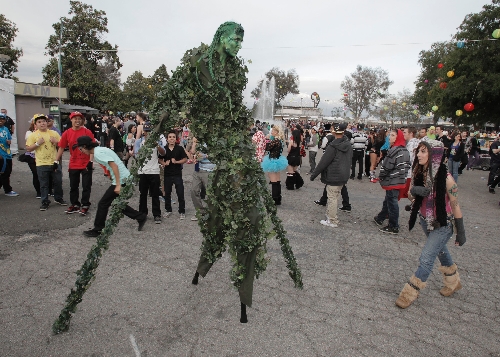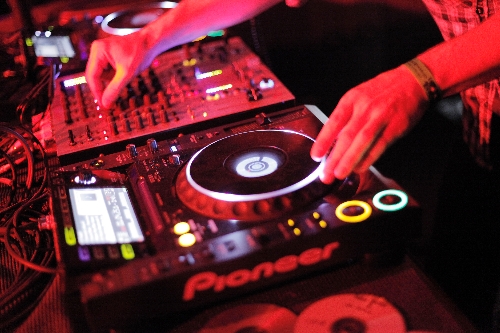Electric Daisy Carnival to electrify Las Vegas
To enter the room is to confront a wall of heat, its mortar secreted from human pores.
It's chilly outside, but in here the air is thick, as dense and heavy as the low frequency bass lines that register right in the gut, roiling innards like indigestion set to a beat.
There are several thousand bodies in motion inside the cavernous exhibition hall, jiggling as if they were cast from Jell-O, generating a palpable energy that warms the surroundings, swallowing the Saturday night cold in a single gulp.
Above, mammoth flower-shaped lights with glimmering disco ball stigmas hang from the arched ceiling, casting off yellow, red and blue hues in broad arcs that create the sensation of wandering through a life-sized kaleidoscope.
Movement is involuntary.
The sheer force of the throbbing house music, conjured by a DJ backed by a monstrous LED screen that pulsates with a pupil-contracting radiance, makes flesh vibrate like a dozen muscle spasms working in unison.
It's a full-body experience, something to be felt as much as heard.
The party's just getting started at the National Orange Show Events Center in San Bernardino, Calif., which, on a recent weekend in March, has been swarmed by Beyond Wonderland, a dance music festival that some 45,000 people attend in a carnival of color and rhythm.
The event encompasses all of the fairgrounds-type, 120-acre layout, with five stages spread throughout various buildings and enormous tents whose length rivals two city blocks.
Walking through the place feels much like being sucked into some far-out anime flick, where towering art installation pieces shoot giant plumes of fire into the sky to the delight of a heavily costumed crowd dressed as everything from rogue bananas to sexy penguins. ¶ In scope and atmosphere, it feels like its own, alternate dimension.
But for as large and all-encompassing as Beyond Wonderland is, it offers but a taste, a hint of the kind of attractions found at the biggest annual event of this kind, the Electric Daisy Carnival, put on by the same company, Insomniac Promotions.
And in a couple of months, it's coming to Las Vegas.
On June 24-26, at the Las Vegas Motor Speedway, EDC will become the valley's largest dance music gathering ever.
"We're in the business of putting on events, and the bigger the event, the better, really," says Chris Powell, Las Vegas Motor Speedway president and general manager. "Certainly, the Electric Daisy Carnival is huge."
Debuting in 1997 when 5,000 revelers packed Los Angeles' Shrine Expo Hall, the carnival has exploded in popularity, drawing more than 180,000 people to downtown L.A. during two days last year, attracting more people daily than such well-known music festivals as Coachella, Bonnaroo and Lollapalooza.
"It's the biggest electronic music event in the world, I'd say," says superstar DJ Paul Oakenfold, who has performed at EDC in the past.
"It's kind of like the Woodstock of our generation," adds Mark Stylz, a resident DJ at Las Vegas properties such as ghostbar, Rain and the Playboy Club. "It's an outlet for people to express themselves through music, an audiovisual, physical, emotional experience."
It's also big business.
According to L.A.-based research and analysis company Beacon Economics, the Electric Daisy Carnival boosted economic output by more than $42 million in Los Angeles County and filled 34,000 hotel rooms.
Locally, EDC is expected to bring in a crowd as big or bigger than the 120,000 who come to Las Vegas for the NASCAR events each spring, which, according to the Las Vegas Convention and Visitors Authority, generated more than $115 million in nongaming revenue in 2010, the most recent year for which statistics are available.
"With 100,000 people, that's a lot of room nights, a lot of dollars being spent in our town. It's a great thing for our economy," says Clark County Commissioner Tom Collins, whose district includes the speedway. "A lot of young people means that they'll be coming to Vegas for many, many, many years."
But the arrival of the Electric Daisy Carnival also comes with some controversy.
At last year's EDC in Los Angeles, a 15-year-old girl died from an overdose of the drug Ecstasy, and more than 100 people were taken to the hospital, many for drug-related incidents, amid more than 100 arrests.
"The number of overdoses we saw was pretty significant," says Bob Green, assistant commanding officer of operations for the south bureau of the Los Angeles Police Department. "We shut down the county emergency room system with transports."
As a result, the city of Los Angeles put a temporary moratorium on such events. It was later lifted, but EDC organizers decided to leave town anyway.
Some Las Vegas and Clark County officials have raised questions about the festival heading here.
"There's a lot of things that have to be talked about," Clark County Commissioner Steve Sisolak says. "You don't want to jeopardize the reputation and good will that's established in Clark County for one event. If something comes here, you want them to come being safe."
Adds Clark County Commissioner Mary Beth Scow, referencing some of the issues the EDC had last summer: "I would have to have some real assurances and be shown that these things would be prevented."
Countering these concerns, others point out that Las Vegas is experienced in hosting events of this magnitude.
"We're very prepared," says Clark County Commission Chairwoman Susan Brager. "I think we're well-versed in that, in regards to the 200,000, 300,000 who come down for New Year's Eve."
Echoing her sentiment is the Las Vegas police department, which will oversee much of the crowd control and security duties.
"We have big events here 30 to 40 times throughout the year," says officer Barb Morgan, spokeswoman for the Metropolitan Police Department. "We're not going to handle this any differently than we do any other big event. This is basically status quo for Metro."
It was when the kids started clambering over the 8-foot fences like prisoners on a jailbreak that Joshua Glazer remembers things getting out of hand.
The scene: the L.A. Coliseum in June, where the Electric Daisy Carnival touched down like a mother ship of light and sound.
By midafternoon, the main staging area had reached capacity, and security had to stop letting people onto the field.
Even though there were numerous other stages for fans to check out, some scaled the two fences erected around the field, then began leaping down, risking injury to themselves and others.
"There was definitely a moment where I was like, 'Oh man, this is bad. Someone's going to get hurt,' " says Glazer, editor and content director for "Urb," a magazine that covers electronic music.
"There were crowd movement issues that I don't think were anticipated," he continues, "but that doesn't mean that you should never allow that many people together again. You need to learn from the mistake. You figure these things out."
EDC organizers have seemingly realized as much.
For the Las Vegas event, the grounds will be five times larger and no fencing will be constructed around the various staging areas.
"Last year (the venue) was undersized," says officer Marcus Martin, a spokesman for Las Vegas police. "The overcrowding created a crush on ticket holders not being able to get in, so, of course, they started to add an additional crush to the problem as they crashed the gates. We don't anticipate those same kind of problems."
Another significant change this year is an age requirement: 18 and older, with IDs scanned upon entrance.
"For security measures, we've definitely focused on implementing some new policies that we didn't have in 2010, which have gone over really well," says Pasquale Rotella, founder and chief executive officer of Insomniac Productions.
These new measures were in place for Beyond Wonderland, which Las Vegas police Capt. Dennis O'Leary attended to get a feel for what was in store when EDC comes to Las Vegas.
He came away reassured by what he saw in San Bernardino.
"I think the promoter did a stand-up job of managing the event. It alleviated or reduced a lot of my concerns that I had going down there," O'Leary says. "You look at it, and you see a bunch of kids who were, by and large, having a good time. I didn't see any fights. Security didn't take any shortcuts when they were checking people in, even when the queues got longer. Those are the things that we'd like to reproduce here, obviously."
To put the L.A. version of EDC into a broader context, there were two other, smaller incarnations of the festival last summer in the Dallas and Denver areas.
Peter Freedman, music editor for the Dallas Observer alternative weekly, covered the Dallas show and says the event went off without incident.
"There was a medic staff on hand. There were cops everywhere," he notes. "Our event was very well-policed and seemed well-managed. Everyone just seemed out for a good time. There were minimal issues."
Police officials in Arapahoe County, Colo., where the Denver-area EDC took place, report some arrests associated with the event, but nothing out of the norm for music events at the same venue.
"We did have some drug violations, some DUIs," Arapahoe County sheriff's Capt. Louie Perea says.
Las Vegas authorities say drug use at Beyond Wonderland in San Bernardino wasn't widespread.
"I saw a very, very small amount, and I did spend a good deal of time visiting with a lot of the kids there," O'Leary says. "I've been doing this job for 22 years, I know what a person under the influence looks like, and the overwhelming majority of people weren't participating in the event like that."
The crowd is as much a part of the show as the DJs onstage, a riot of flesh and fishnets, eye-popping pastels and hot pants.
Some come costumed as sexy woodland creatures, sporting bunny ears with whiskers painted on their faces; others look like rainbows incarnate in dazzling red, orange and yellow wigs and matching furry boots that look as if they were fashioned from a skinned Wookiee.
The whole scene, a snapshot of the Beyond Wonderland crowd, feels like something from one of Willie Wonka's daydreams, a candy-colored cartoon world where there are no outsiders because everyone's an outsider in his or her own way.
"It's a look-at-me sort of crowd and, at the same time, a nobody's-looking crowd because no one would dress like that if people were looking at them," Glazer says, chuckling. "It's a judgment-free zone."
It all engenders a communal, come-as-you-are vibe about these types of dance music events, which have evolved greatly over the years.
Their origins are rooted in the rave scene of the late '80s and early '90s, which was characterized by underground parties thrown guerrilla-style in nontraditional venues, such as abandoned warehouses and lofts.
Because they were unlicensed parties, at least at first, they were defined in part by an outlaw spirit, fostering a secretive subculture that catered to a comparatively small in-crowd.
Those days are long gone.
"Rave" is no longer a tag that befits something as heavily regulated, promoted and monetized as these festivals have become.
" 'Rave' doesn't begin to explain what this is," DJ Stylz says of the Electric Daisy Carnival. "That's such an archaic word for it. That just comes with that negative connotation of what undergrounds were."
The sheer scope of something like EDC belies anything done on the down low. Production costs run into the millions, and it's all coordinated with local officials.
"It's not in a dark little warehouse," says DJ Loczi, a resident at Studio 54 at the MGM Grand. "This is a festival thrown in conjunction with cities, with major planning, a tremendous budget. It's a legitimate festival with legitimate stages and a full production."
The steady advancement of dance music culture as exemplified by events such as EDC dovetails with the development of the DJ community at large.
Nowadays, DJs such as David Guetta are working with pop artists such as Katy Perry, the Black Eyed Peas and Snoop Dogg, as dance music increasingly infiltrates the mainstream via several avenues.
Las Vegas has seen that development firsthand, becoming the premier U.S. city for such music, with a vibrant scene that has been able to lure superstar DJs such as Tiesto and Oakenfold to town for residencies in recent years.
"Vegas is the hub for electronic music in America," Oakenfold says. "I had L.A. and New York offering me residencies, but Vegas has always reminded me of what Ibiza is to the Europeans: It's a playground for people who want to go and have a great time, who want to party. I always felt that Vegas was the future."
Recently, Nightclub & Bar, a night-life-centered media company, released its annual ranking of the top 100 clubs in America based on total revenue. Las Vegas properties accounted for a whopping nine of the top 10 venues, with clubs such as XS and Tao raking in $60 million to $70 million a year.
"Vegas is a destination city for the folks that are really looking for an outstanding night-life experience," said Donna Hood Crecca, editorial director of Nightclub & Bar, earlier in the year. "In terms of the level of service, the technology that you see in the clubs, the sound systems, the lighting systems, the interactive element that's coming into some of them, and also the trends in designs and decor, Vegas sets the standards for all of that."
It's this community that is coming to define the city and usher it away from the outdated, Wayne Newton clichés.
"This culture resurrected Vegas when it was going to be Vegasland and carnivals," Stylz says. "It's the nightclubs that brought the city back and gave it a rebirth."
Many within the Vegas DJ ranks look for Electric Daisy Carnival to further cement the city's reputation as a dance music capital.
"It's such a big deal for Vegas," says San Francisco-based DJ E-Rock, a resident at various properties at the Palms. "So many people are going to be going. I can only imagine how much bigger it's going to be when it's in Vegas because it will have an industry that can support it really hard."
With a much larger space to house the event, EDC organizers say it will be the most elaborate event they've attempted.
"We're definitely going bigger with production and art and even the lineup," Insomniac's Pasquale says. "Logistically, we have the room to do stuff that's unique to even what we've done in the past."
As much as the club scene has nurtured the development of the dance music ranks in Las Vegas, EDC will cast a broader, more inclusive net, with no never-ending lines or wallet-busting bottle service that come with the high-end night-life circuit.
In short, the crowd probably will be more what you would see in San Bernardino than here at The Bank.
"The theme is acceptance," Stylz says. "You go there, and you feel the love in the air."
Back in San Bernardino in March, a stout, thick-shouldered security guard named Justin keeps watch over one of many Beyond Wonderland parking lots.
He's pulling a 17-hour shift and will be here well into Sunday morning.
He has worked at shows like these in the past, and when asked whether he's had many run-ins with problematic crowd members or if it's a particularly unruly audience, he shakes his head a little bemusedly, as if the reporter posing the question should know better.
He sums things up matter-of-factly, then goes back to looking bored.
"It's just a bunch of kids who want to listen to loud music."
Contact reporter Jason Bracelin at jbracelin@reviewjournal.com or 702-383-0476.
PREVIEW
What: Electric Daisy Carnival with multiple stages and elaborate production values
When: June 24-26
Where: Las Vegas Motor Speedway
Tickets: Tickets available April 23 at noon at insomniac.com. Single day tickets $75-$100. Three-day tickets $180-$250. VIP tickets for single day $200-$250. VIP three-day tickets $500-$600.




